Reverse-Engineering NES Tetris to add Hard Drop
Tetris for the NES is one of my favourite versions of Tetris. My only complaint is that it lacks the ability to “hard drop” - instantly dropping the current piece and locking it into place.
Let’s change that!
This post describes a modification I made to NES Tetris so that pressing the “up” button causes the current piece to hard drop, and so that the game renders a “ghost piece” - a dotted outline of the current piece showing where it will land.

Soft Drop and Hard Drop
The current piece moves down one space each game tick. Tetris implementations typically provide two ways for speeding this up - soft drop and hard drop.
For soft drop, pressing a button will instantly move the current piece down one space, and holding the button will cause it to drop faster than it otherwise would.
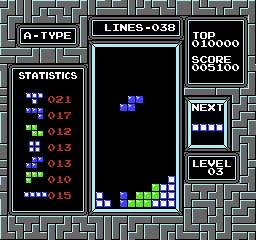
Hard drop instantly drops the current piece and locks it into place. Because it can be difficult for the player to visually tell whether the piece is lined up with where they want it to land, Tetris implementations with hard drop usually display a ghost piece showing where the current piece will end up.
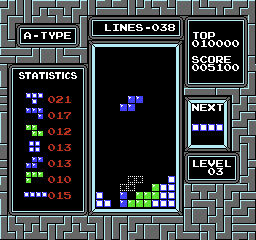
Prior to my changes, NES Tetris only supported soft drop.
The Artefact
I made a rust program which reads a NES ROM file in INES format. If its input was NES Tetris (usually in a file named something like “Tetris (U) [!].nes”), it will produce as output, a new NES ROM file which is NES Tetris, patched to have hard drop.
The input file should have a sha1 hash of a99f922e9da20b2a27e4398348505d2e9d15271b.
$ cargo install nes-tetris-hard-drop-patcher # install my tool
$ nes-tetris-hard-drop-patcher < 'Tetris (U) [!].nes' > tetris-hd.nes # patch a NES Tetris ROM
$ fceux tetris-hd.nes # run the result in an emulator
This tool relies on the user to obtain an NES Tetris ROM file. It doesn’t have Tetris built-in. The resulting ROM file is compatible with all NES emulators - it’s not specific to fceux.
Patch
After sharing this post online some folks pointed out that there is a standard format for ROM patches (IPS) that is widely supported by emulators. Get the NES Tetris hard drop patch here.
Tooling
A couple of years ago I made a NES Emulator. It turns out to be a useful reverse-engineering tool, as it’s easy to instrument the emulator to conduct experiments on the program it’s running. In particular, the ability to log every instruction, interleaved with interesting events such as video memory updates, came in very handy. Also it can render to gifs, and I used it to generate all the animations in this post!
To test my emulator, I made a rust library for writing NES assembly programs in a rust embedded domain-specific language. Here’s an example that multiplies the value in the “accumulator” register by 12:
b.inst(Clc, ()); // clear carry flag
b.inst(Rol(Accumulator), ()); // rotate accumulator 1 bit to the left (x2)
b.inst(Rol(Accumulator), ()); // rotate accumulator 1 bit to the left (x4)
b.inst(Sta(ZeroPage), 0x20); // store current accumulator value at address 0x0020
b.inst(Rol(Accumulator), ()); // rotate accumulator 1 bit to the left (x8)
b.inst(Adc(ZeroPage), 0x20); // add the accumulator with the value at 0x0020 (x12)
This lets me use rust as a macro language for NES assembly programs. The flexibility this affords is essential when tacking custom code onto an existing program written in the 80s.
While debugging my emulator I made a simple disassembler that can display per-function assembly of NES programs.
Finally, I used a third-party NES emulator named Mesen which boasts a rich set of debugging tools. This was helpful for getting an understanding of the current contents of memory, and the current state of the graphics chip.
Rendering the Ghost Piece
The NES has two different types of graphics:
- the background is a grid of 8x8 pixel tiles
- sprites are tiles which can be drawn at arbitrary positions on the screen
Most games use a combination of both, and Tetris is no exception.
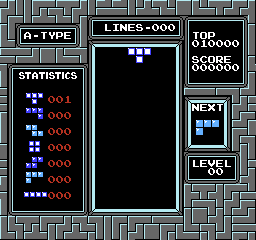
Tetris uses sprites to draw the current piece and the next piece, and background graphics for everything else. The images below isolate the two types of graphics in the scene above, with the background on the left and sprites on the right.
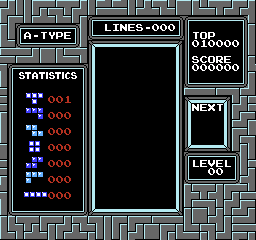
The game clearly has logic already for drawing the current piece using sprites, so the easiest way of rendering the ghost piece seems to be re-using that logic, but using a ghostly tile rather than the normal tile.
Speaking of ghostly tiles, I added a new tile to the game to use for the ghost piece:

My goal here is to hunt down the part of Tetris that renders the current piece in order to reappropriate that code for rendering the ghost piece.
To render sprites on the NES, you populate a region of main memory with sprite metadata (position, tile, etc), then write the address of the start of this memory region to the OAMDMA register. (Object Attribute Memory Direct Memory Access - OAM is special memory for storing sprite metadata, and DMA is a general term for devices reading and writing main memory directly.) Writing an address to OAMDMA causes the graphics hardware on the NES to copy sprite metadata out of the specified region of main memory, and into specialised Object Attribute Memory which will be consulted during rendering to draw the sprites.
The OAMDMA register is mapped into the CPU’s address space at address 0x4014.
Searching the disassembled program for this address reveals:
0xAB63 Lda(Immediate) 0x02 # load accumulator with 2
0xAB65 Sta(Absolute) 0x4014 # write accumulator to 0x4014
This writes the value 2 to OAMDMA causing the memory from 0x0200 to 0x02FF to be copied to OAM.
Searching the code for 0x0200, and one function in particular jumps out as being responsible
for populating the OAM DMA buffer. This function is at 0x8A0A and can tell us a great deal
about how Tetris works.
It starts by reading values from addresses 0x0040 and 0x0041, multiplying each by 8, and adding them to some offsets.
On the NES, each tile is 8x8 pixels, so this appears to be translating from a tile coordinate into a pixel coordinate,
where the offsets are the components of the pixel coordinate of the top left corner of the board.
A few minutes poking around in mesen confirms this - 0x40 is the x coordinate, and 0x41 is the Y coordinate of the current piece.
The function then reads from 0x42. This location always contains a value between 0 and 18 which appears to encode the
shape of the current piece, as well as its rotation. For shapes with rotational symmetry (such as the “S” piece), the
multiple identical rotations get a single value in 0x42. I’ll refer to this value as the “shape index”.
Each piece in Tetris is made up of 4 tiles, and one sprite is rendered for each tile.
The coordinate in 0x40 and 0x41 is the position of the piece, but in order to render the
sprites we must find out the position of each tile. To this end, this function consults a table in ROM
at address 0x8A9C which I’ll refer to as the “shape table”. Each of the 19 pieces (including unique rotations)
has a 12-byte entry in the shape table. The shape table entry for a piece stores 3 bytes for each of the 4 tiles:
- the y offset of the tile (relative to
0x41) - the index of the sprite to use when rendering the tile
- the x offset of the tile (relative to
0x40)
This function computes the location and sprite index of each tile of the current piece, and populates the OAM DMA buffer with this information. To render the ghost piece, I need a similar function, except it renders each tile with the ghost tile rather than the tile from the shape table, and it renders the piece at a vertical offset so that the piece appears at the location where it would land after a hard drop. It would be non-trivial to modify this function in-place to be general over the ghost piece and regular piece, so instead I copy/pasted the code and changed it to do what I need.
I started by using mesen’s memory viewer to locate a seemingly unused region of ROM.
I don’t know why it’s striped with 0x00 and 0xFF! Also I don’t know how to change mesen’s font to be monospace!
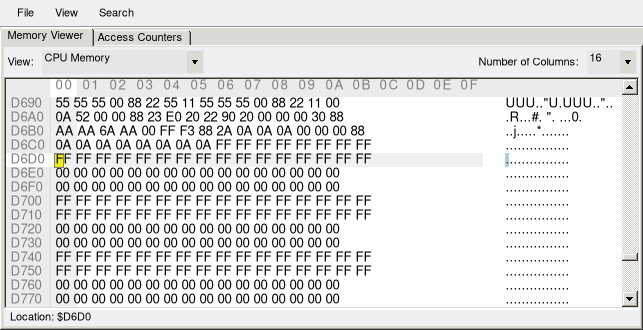
I claimed 512 bytes of memory starting at address 0xD6D0. The first code I added to this region was
a function that simply calls the existing OAM DMA buffer update function:
b.label("oam-dma-buffer-update");
// Call original function
b.inst(Jsr(Absolute), 0x8A0A);
// Return
b.inst(Rts, ());
My patching tool replaces all calls to the original function (0x8A0A) with calls to this new one.
Next I took the disassembled code from the original OAM DMA buffer update function and hand-translated it into my rust domain-specific language for NES assembly.
This:
0x8A0A Lda(ZeroPage) 0x40
0x8A0C Asl(Accumulator)
0x8A0D Asl(Accumulator)
0x8A0E Asl(Accumulator)
0x8A0F Adc(Immediate) 0x60
0x8A11 Sta(ZeroPage) 0xAA
...
…becomes:
b.label("render-ghost-piece"); // function label so it can be called by name later
b.inst(Lda(ZeroPage), 0x40);
b.inst(Asl(Accumulator), ());
b.inst(Asl(Accumulator), ());
b.inst(Asl(Accumulator), ());
b.inst(Adc(Immediate), 0x60);
b.inst(Sta(ZeroPage), 0xAA);
...
I modified my copy of the OAM DMA buffer update to use the ghost tile instead of the tile
read from the shape buffer. To test this change, I updated oam-dma-buffer-update to call
this function instead of the original:
b.label("oam-dma-buffer-update");
// Call new function
b.inst(Jsr(Absolute), "render-ghost-piece");
// Return
b.inst(Rts, ());
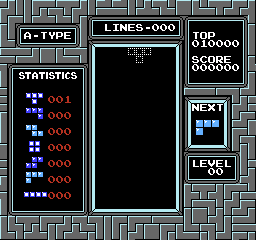
Next I made my ghost-piece-rendering function take an argument specifying the vertical distance below the current piece at which it should render the ghost piece. Eventually this will be computed based on how many times the piece could move downwards before colliding, but first I tried calling it with a constant (6).
b.label("oam-dma-buffer-update");
// Call original function first
b.inst(Jsr(Absolute), 0x8A0A);
// Render the ghost piece, passing the vertical offset argument in address `0x0028`.
b.inst(Lda(Immediate), 6);
b.inst(Sta(ZeroPage), 0x28);
b.inst(Jsr(Absolute), "render-ghost-piece");
// Return
b.inst(Rts, ());
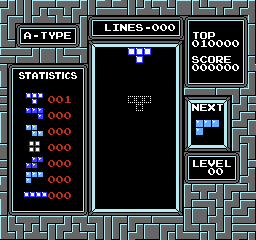
Now to compute the true vertical offset from the current piece to the place it would land after
dropping. By watching memory with mesen, I observed that nothing seemed to be using memory from 0x0020 to 0x0028.
The first 256 bytes of memory is referred to as the “zero page” and affords faster access than the rest of memory.
I wanted 8 zero page bytes to store the X,Y coordinates of each tile of the current piece during collision detection,
and one additional byte to store temporary values during computation.
Start by initializing the values at 0x20 to 0x27 to the X,Y coordinates of each tile of the current piece:
b.label("compute-hard-drop-distance"); // function label so it can be called by name later
const SHAPE_TABLE: Address = 0x8A9C;
const ZP_PIECE_COORD_X: u8 = 0x40;
const ZP_PIECE_COORD_Y: u8 = 0x41;
const ZP_PIECE_SHAPE: u8 = 0x42;
// Multiply the shape by 12 to make an offset into the shape table,
// storing the result in IndexRegisterX.
b.inst(Lda(ZeroPage), ZP_PIECE_SHAPE); // read shape index into accumulator
b.inst(Clc, ()); // clear carry flag to prepare for arithmetic
b.inst(Rol(Accumulator), ()); // rotate left: index * 2
b.inst(Rol(Accumulator), ()); // rotate left: index * 4
b.inst(Sta(ZeroPage), 0x20); // store index * 4 at 0x0020
b.inst(Rol(Accumulator), ()); // rotate left: index * 8
b.inst(Adc(ZeroPage), 0x20); // add to 0x0020: index * 12
b.inst(Tax, ()); // transfer accumulator to IndexRegisterX
// Store absolute X,Y coords of each tile by reading relative coordinates from shape table
// and adding the piece offset, storing the result in zero page 0x20..=0x27.
for i in 0..4 { // this is a rust loop - the assembly generated inside will be generated 4 times
b.inst(Lda(AbsoluteXIndexed), Addr(SHAPE_TABLE)); // read Y offset from shape table
b.inst(Clc, ()); // clear carry flag to prepare for addition
b.inst(Adc(ZeroPage), ZP_PIECE_COORD_Y); // add to Y coordinate of piece
b.inst(Sta(ZeroPage), 0x21 + (i * 2)); // store the result in zero page
b.inst(Inx, ()); // increment IndexRegisterX to sprite index
b.inst(Inx, ()); // increment IndexRegisterX to X offset
b.inst(Lda(AbsoluteXIndexed), Addr(SHAPE_TABLE)); // read X offset from shape table
b.inst(Clc, ()); // clear carry flag to prepare for addition
b.inst(Adc(ZeroPage), ZP_PIECE_COORD_X); // add to X coordinate of piece
b.inst(Sta(ZeroPage), 0x20 + (i * 2)); // store the result in zero page
b.inst(Inx, ()); // increment IndexRegisterX to next tile
}
Now for the actual collision detection!
Repeatedly increment the Y component of each tile coordinate in the 0x20 to 0x27 addresses
until one of the tiles either collides with a locked-in tile, or goes off the bottom of the
board.
By examining memory with mesen, I learnt that the board state is stored as a row-major array
of sprite indices beginning at 0x0400, and that 0xEF is the index of the “empty space” tile.
The strategy will be to use the coordinate of each tile to construct an index into this
array, and stop if anything other than 0xEF is found.
A possible point of confusion in the code below is that it implements a loop in assembly, but there is also a rust for-loop that generates assembly. These two loops are unrelated. The assembly code in the rust loop is emitted 4 times, and the result makes up the body of the assembly loop.
const BOARD_TILES: Address = 0x0400;
const EMPTY_TILE: u8 = 0xEF;
const BOARD_HEIGHT: u8 = 20;
b.inst(Ldx(Immediate), 0); // Load 0 into IndexRegisterX - this will be our loop counter
b.label("start-ghost-depth-loop"); // This is a label - a target for branch instructions
for i in 0..4 { // the assembly in this rust loop will be emitted 4 times
// Increment the Y component of the coordinate
b.inst(Inc(ZeroPage), 0x21 + (i * 2));
// Break out of the loop if the tile is off the bottom of the board
b.inst(Lda(ZeroPage), 0x21 + (i * 2));
b.inst(Cmp(Immediate), BOARD_HEIGHT);
b.inst(Bpl, LabelRelativeOffset("end-ghost-depth-loop"));
// Multiply the Y component of the coordinate by 10 (the number of columns)
b.inst(Asl(Accumulator), ());
b.inst(Sta(ZeroPage), 0x28); // store Y * 2
b.inst(Asl(Accumulator), ());
b.inst(Asl(Accumulator), ()); // accumulator now contains Y * 8
b.inst(Clc, ());
b.inst(Adc(ZeroPage), 0x28); // accumulator now contains Y * 10
// Now add the X component to get the row-major index of the cell
b.inst(Adc(ZeroPage), 0x20 + (i * 2));
// Load the tile at that coordinate
b.inst(Tay, ());
b.inst(Lda(AbsoluteYIndexed), BOARD_TILES);
// Test whether the tile is empty, breaking out of the loop if it is not
b.inst(Cmp(Immediate), EMPTY_TILE);
b.inst(Bne, LabelRelativeOffset("end-ghost-depth-loop"));
}
// Increment counter and loop
b.inst(Inx, ());
b.inst(Jmp(Absolute), "start-ghost-depth-loop");
b.label("end-ghost-depth-loop");
This results with IndexRegisterX containing the number of times the loop iterated, which is
also the vertical distance from the current piece to where it will end up after dropping.
For the convenience of callers, this function will return this result via the accumulator register:
// Return depth via accumulator
b.inst(Txa, ()); // transfer IndexRegisterX to accumulator
b.inst(Rts, ()); // return
The full body of the replacement OAM DMA buffer update function is now:
b.label("oam-dma-buffer-update");
// Call original function first
b.inst(Jsr(Absolute), 0x8A0A);
// Compute distance from current piece to drop destination, placing result in accumulator
b.inst(Jsr(Absolute), "compute-hard-drop-distance");
// Check if the distance is 0, and skip rendering the ghost piece in this case
b.inst(Beq, LabelRelativeOffset("after-render-ghost-piece"));
// Render the ghost piece, passing the vertical offset argument in address `0x0028`.
b.inst(Sta(ZeroPage), 0x28);
b.inst(Jsr(Absolute), "render-ghost-piece");
b.label("after-render-ghost-piece");
// Return
b.inst(Rts, ());
The result:
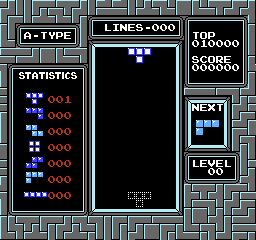
Adding the Hard Drop Control
Now that the ghost piece is rendering, the next step is to make it so that when the “up” button on the controller is pressed, the hard drop happens. The “up” button isn’t used by Tetris, so we don’t have to worry about losing some functionality in order to gain hard drop.
As with adding the ghost piece, I set out to find a function that I could replace with a new function that calls the original before doing extra stuff - in this case checking whether “up” was pressed, and hard dropping if so.
My first attempt was to look for code that reads the controller state register 0x4016, but
there seems to be a fair bit of indirection between reading that register and updating the
game state based on which buttons are pressed.
My second idea was to instrument my emulator to log every instruction executed. I loaded up Tetris, and navigated the menus to start a new game, then saved a state file. My emulator has an option to run for a specific number of frames. I set it up to run for 20 frames, loaded the state file, and logged each instruction without pressing any controls. Then I repeated this process, however this time around I pressed the left button during the 20 frame window. I now had two logs of the instruction stream - one with no controls pressed, and a second with a control pressed. It stands to reason that the first place where these streams differ would be the first time the program branched on the state of the left button.
Sure enough:
@@ -116912,9 +116912,175 @@
0x89B8 Lda(ZeroPage) 0xB5
0x89BA And(Immediate) 0x03
0x89BC Bne(Relative) 0x15
-0x89BE Lda(ZeroPage) 0xB6
-0x89C0 And(Immediate) 0x03
-0x89C2 Beq(Relative) 0x45
+0x89D3 Lda(Immediate) 0x00
+0x89D5 Sta(ZeroPage) 0x46
+0x89D7 Lda(ZeroPage) 0xB6
+0x89D9 And(Immediate) 0x01
+0x89DB Beq(Relative) 0x0F
...
Cross-referencing this with the disassembled ROM, this function begins with:
0x89AE Lda(ZeroPage) 0x40
0x89B0 Sta(ZeroPage) 0xAE
0x89B2 Lda(ZeroPage) 0xB6
0x89B4 And(Immediate) 0x04
0x89B6 Bne(Relative) 0x51 (relative: 0x51, absolute: 0x8A09)
0x89B8 Lda(ZeroPage) 0xB5
0x89BA And(Immediate) 0x03
0x89BC Bne(Relative) 0x15 (relative: 0x15, absolute: 0x89D3)
0x89BE Lda(ZeroPage) 0xB6
0x89C0 And(Immediate) 0x03
0x89C2 Beq(Relative) 0x45 (relative: 0x45, absolute: 0x8A09)
...
This branches based on the contents of addresses 0x00B5 and 0x00B6.
Watching these addresses in mesen while mashing the controls gives me the impression that
0xB5 stores the frame to frame differences in controller state, and 0xB6 stores the
current controller state. Despite not being used by Tetris, the state of the “up” button
is reflected in these values.
I started this function the same as my replacement for OAM DMA buffer update - all it did was call the original function and return:
b.label("handle-controls");
// Call the original function
b.inst(Jsr(Absolute), 0x89AE);
// Return
b.inst(Rts, ());
Now add a check for whether the “up” button is pressed. For now, just teleport the current piece to a fixed height when the button is pressed:
b.label("handle-controls");
const CONTROLLER_STATE: u8 = 0xB6;
const CONTROLLER_BIT_UP: u8 = 0x08;
// Call the original function
b.inst(Jsr(Absolute), 0x89AE);
// Skip to the end if the UP bit of the controller state is not set
b.inst(Lda(ZeroPage), CONTROLLER_STATE);
b.inst(And(Immediate), CONTROLLER_BIT_UP);
b.inst(Beq, LabelRelativeOffset("controller-end"));
// Set the current piece's Y coordinate to 7
b.inst(Lda(Immediate), 7);
b.inst(Sta(ZeroPage), ZP_PIECE_COORD_Y);
b.label("controller-end");
// Return
b.inst(Rts, ());
Here’s the code in action, with me pressing “up” multiple times:
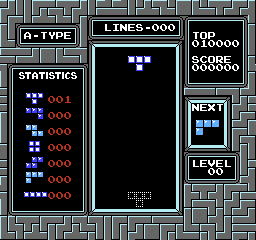
Next, replace the testing constant 7 with the actual position that the
piece will end up after hard dropping. Use the compute-hard-drop-distance
function we wrote for ghost piece rendering, then just add the current
position of the piece to get the absolute Y coordinate it will end up at
after dropping:
b.label("handle-controls");
const CONTROLLER_STATE: u8 = 0xB6;
const CONTROLLER_BIT_UP: u8 = 0x08;
// Call the original function
b.inst(Jsr(Absolute), 0x89AE);
// Skip to the end if the UP bit of the controller state is not set
b.inst(Lda(ZeroPage), CONTROLLER_STATE);
b.inst(And(Immediate), CONTROLLER_BIT_UP);
b.inst(Beq, LabelRelativeOffset("controller-end"));
// Compute distance from current piece to drop destination, placing result in accumulator
b.inst(Jsr(Absolute), "compute-hard-drop-distance");
// Add the current piece's Y coordinate
b.inst(Clc, ());
b.inst(Adc(ZeroPage), ZP_PIECE_COORD_Y);
// Update the current piece's Y coordinate with the result
b.inst(Sta(ZeroPage), ZP_PIECE_COORD_Y);
b.label("controller-end");
// Return
b.inst(Rts, ());
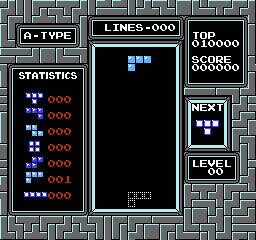
That’s looking pretty good!
There’s a minor issue with timing though. It appears the game is waiting until the end of the current “tick” before spawning the next piece. After a hard drop, the current tick should end immediately and the next piece should spawn without delay.
Looking at the memory with mesen, it looks like there’s a counter at 0x0045 counting up to some number
and then resetting on the next tick (when the current piece moves down on its own).
To learn more, I had my emulator log all instructions and ran the game for 13 ticks.
I chose 13 because it seemed unlikely to appear by accident.

During this run, the timer would have expired 13 times. Somewhere in the instruction log there is a related instruction that was executed exactly 13 times. Let’s find it!
The instruction log is in a file named /tmp/log.txt:
cat /tmp/log.txt | sort | uniq --count | sort --numeric-sort
This makes a histogram of instructions by frequency. Perusing the instructions that were executed 13 times, I spotted:
13 0x8958 Lda(Immediate) 0x00
13 0x895A Sta(ZeroPage) 0x45
It seems relevant because it interacts with the timer at 0x0045!
Consulting the disassembled code around that instruction:
0x8980 Lda(ZeroPage) 0x45 # load the timer value
0x8982 Cmp(ZeroPage) 0xAF # compare with the value at 0x00AF
0x8984 Bpl(Relative) 0xD2 (relative: D2, absolute: 8958) # branch if it was higher
0x8986 Jmp(Absolute) 0x8972
0x8972 Rts(Implied)
0x8958 Lda(Immediate) 0x00 # load 0 into the accumulator
0x895A Sta(ZeroPage) 0x45 # store the accumulator (0) in the timer
Those last two instructions set the timer value to 0, and they’re executed exactly 13 times.
The only way to get to these instructions is via the branch (0x8984) which means the branch condition
is only true 13 times - likely once per tick.
So a likely narrative is that the timer is incremented each frame and the frame on which it becomes larger
than the value in 0xAF marks the end of the current tick at which point the timer is reset and the current piece moves down.
Watching 0x00AF in mesen, and it appears to be the maximum value that the timer in 0x0045 reaches.
Furthermore, when you complete a level, the value in 0x00AF is decreased, speeding up the game!
So after a hard drop, just set the timer value to be the value in 0x00AF:
b.label("handle-controls");
const CONTROLLER_STATE: u8 = 0xB6;
const CONTROLLER_BIT_UP: u8 = 0x08;
const TIMER: u8 = 0x45;
const TIMER_MAX: u8 = 0xAF;
// Call the original function
b.inst(Jsr(Absolute), 0x89AE);
// Skip to the end if the UP bit of the controller state is not set
b.inst(Lda(ZeroPage), CONTROLLER_STATE);
b.inst(And(Immediate), CONTROLLER_BIT_UP);
b.inst(Beq, LabelRelativeOffset("controller-end"));
// Compute distance from current piece to drop destination, placing result in accumulator
b.inst(Jsr(Absolute), "compute-hard-drop-distance");
// Add the current piece's Y coordinate
b.inst(Clc, ());
b.inst(Adc(ZeroPage), ZP_PIECE_COORD_Y);
// Update the current piece's Y coordinate with the result
b.inst(Sta(ZeroPage), ZP_PIECE_COORD_Y);
// Set the timer to its maximum value
b.inst(Lda(ZeroPage), TIMER);
b.inst(Sta(ZeroPage), TIMER_MAX);
b.label("controller-end");
// Return
b.inst(Rts, ());
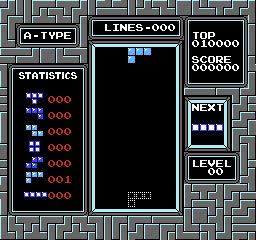
Looking better, but there’s still a long delay if you hard drop the first piece during the first tick.
It turns out that the first tick takes longer than all the other ticks.
Staring at the memory in mesen, I noticed the value at 0x004E counting up during the first
tick. It’s set to 0 during all other ticks. Setting it to 0 after a hard drop appears to
fix the timing issue.
b.label("handle-controls");
const CONTROLLER_STATE: u8 = 0xB6;
const CONTROLLER_BIT_UP: u8 = 0x08;
const TIMER: u8 = 0x45;
const TIMER_MAX: u8 = 0xAF;
const TIMER_FIRST_TICK: u8 = 0x4E;
// Call the original function
b.inst(Jsr(Absolute), 0x89AE);
// Skip to the end if the UP bit of the controller state is not set
b.inst(Lda(ZeroPage), CONTROLLER_STATE);
b.inst(And(Immediate), CONTROLLER_BIT_UP);
b.inst(Beq, LabelRelativeOffset("controller-end"));
// Compute distance from current piece to drop destination, placing result in accumulator
b.inst(Jsr(Absolute), "compute-hard-drop-distance");
// Add the current piece's Y coordinate
b.inst(Clc, ());
b.inst(Adc(ZeroPage), ZP_PIECE_COORD_Y);
// Update the current piece's Y coordinate with the result
b.inst(Sta(ZeroPage), ZP_PIECE_COORD_Y);
// Set the timer to its maximum value
b.inst(Lda(ZeroPage), TIMER);
b.inst(Sta(ZeroPage), TIMER_MAX);
// Clear the first tick timer
b.inst(Lda(Immediate), 0x00);
b.inst(Sta(ZeroPage), TIMER_FIRST_TICK);
b.label("controller-end");
// Return
b.inst(Rts, ());
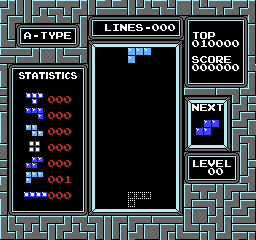
That appears to be working!
The source code for the patching tool is available on github.
Download the IPS patch that applies the change described in this post here.
A second patch that adds hard drop but doesn’t show the ghost piece is available here.